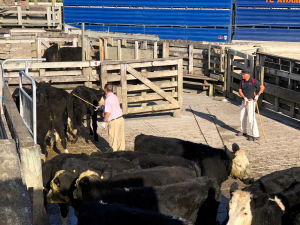M.I.A.
OPINION: The previous government spent too much during the Covid-19 pandemic, despite warnings from officials, according to a briefing released by the Treasury.
 Both the Frankton and Stratford sales were very successful, according to NZ Farmers Livestock general manager, Bill Sweeney.
Both the Frankton and Stratford sales were very successful, according to NZ Farmers Livestock general manager, Bill Sweeney.
After weeks of silence, the Frankton sale yards were bustling with yards of stock up for auction on Wednesday.
The sale marks the restart of NZ Farmers Livestock auctions and saw a hybrid of in-yard bidding, along with on-line bidding.
The Frankton sale is the first of four across the country within the next week. Stratford ran very well the next day with a complete clearance. Morrinsville, and Te Kuiti restart next week with Rongotea the week after. Normal saleyard and other advertised yard and on-farm sales continue from there.
Bill Sweeney, NZ Farmers Livestock general manager, said both the Frankton and Stratford sales were very successful with both in-yard and on-line bidders competing for stock in a seamless, real-time manner.
“The safety of everyone involved in livestock sales is a constant focus and we devoted a huge amount of time over several weeks ensuring COVID-19 safety for all participants.
“Having proven that the Level 3 COVID-19 safety arrangements we developed are keeping people safe, NZ Farmers Livestock is now working to bring this capability to other livestock saleyards, and scheduling on-farm sales using the hybrid bidding options.
“There was a very high clearance of the stock on sale at Frankton and we were pleased with prices in what has become a very uncertain market. Sale details will support wider price discovery within the industry, and this performance and level of successful sale completion reinforces the importance of saleyard and on-farm auctions for farmers, particularly when compared to the relatively poor results from the on-line only alternative platforms.”
“A huge team effort brought together the technical capability to support real auctions in NZ with on-line bidding capability with the protocols, arrangements and attendee behaviours to ensure a COVID-safe and successful sale,” Sweeny says.
“This restart under Level 3 has come in the nick of time for a lot of dairy farmers, with many still needing to sell part or whole dairy herds before the June changeover and start of the 2020-21 season.”
Legal controls on the movement of fruits and vegetables are now in place in Auckland’s Mt Roskill suburb, says Biosecurity New Zealand Commissioner North Mike Inglis.
Arable growers worried that some weeds in their crops may have developed herbicide resistance can now get the suspected plants tested for free.
Fruit growers and exporters are worried following the discovery of a male Queensland fruit fly in Auckland this week.
Dairy prices have jumped in the overnight Global Dairy Trade (GDT) auction, breaking a five-month negative streak.
Alliance Group chief executive Willie Wiese is leaving the company after three years in the role.
A booklet produced in 2025 by the Rotoiti 15 trust, Department of Conservation and Scion – now part of the Bioeconomy Science Institute – aims to help people identify insect pests and diseases.

OPINION: The release of the Natural Environment Bill and Planning Bill to replace the Resource Management Act is a red-letter day…
OPINION: Federated Farmers has launched a new campaign, swapping ‘The Twelve Days of Christmas’ for ‘The Twelve Pests of Christmas’ to…